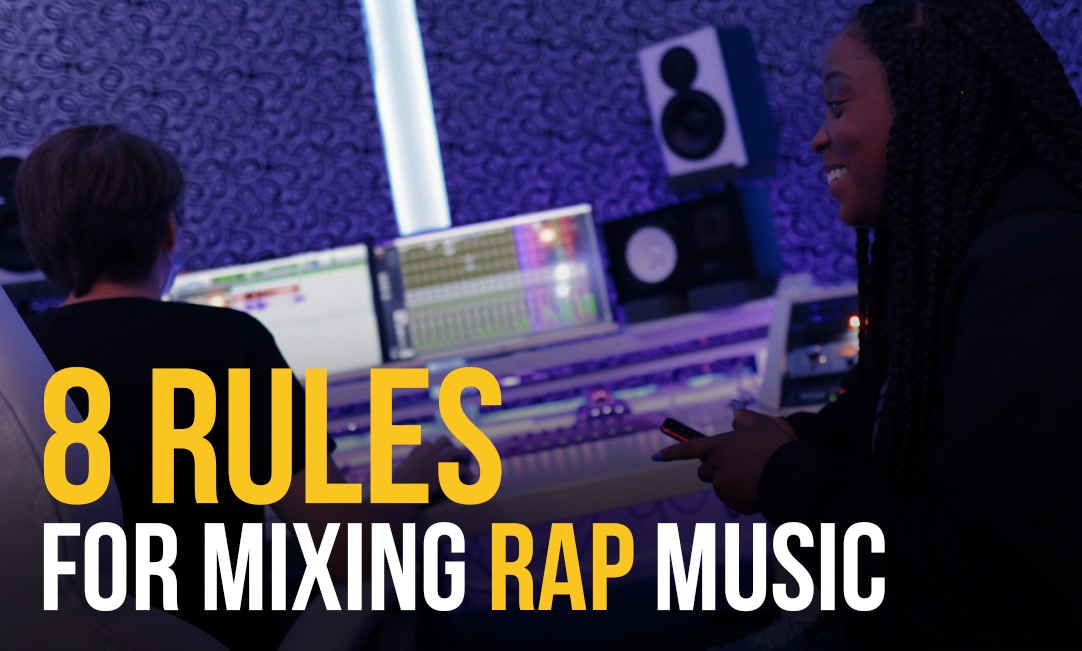8 Rules For Mixing Rap Music

It may be both exhilarating and tough to mix rap with hip-hop. On the one side, you have the option to experiment with more creative mixing techniques such as vocal throws, which can be heard in many of today's most successful hip-hop recordings. Mixing rap, on the other hand, presents a new set of obstacles, such as balancing the voice against the beat and dialing in the proper quantity of vocalist polish against the kick and bass's full low-end presence.
To assist you in achieving both, I'd like to provide eight mixing strategies for hip-hop and rap which can help you get the professional sound you're after in your production:
Audio clipping is a prevalent problem in rapping and hip-hop compositions as a result of the desire to have the sharpest track possible. Audio clipping is a type of degradation that happens when signal levels exceed a device's limit. Vocals are frequently recorded as "too hot" in rap and hip-hop, meaning they've exceeded the boundary of 0 dBFS, resulting in undesired distortion. The first (and simplest) technique to prevent ripping is to make damn sure your recording levels are correct. However, if you are unable to re-record the voice, some processing may be required to fix it. You can run vocalists (and every other recording) through this process if they have been cut. For Music, RX Pro's De-clip command to undo any clipping that has occurred. De-clipping is a great way to reduce disturbance in your recordings.
2. Split the bass to get a hard-hitting sound
Here's a brilliant method for getting your bass to hit hard and clear: split it in half. Make a copy of your pre-existing bassline and play it with a pure sine wave. Then, using a rectifier in an EQ, cut the bottom end of the original bass (anything below roughly 60–90 Hz on down). To listen to what something seems like during splitting a bass note, listen to the audio sample below. However, to truly hear such low frequencies, make sure you're listening with decent headphones or mixing monitors.
3. Rhythm and clean reverb should be used to keep vocals tight
When combining rap with hip-hop, a sloppy vocal portion is a common mistake. Rappers usually record layered vocals, a double, as well as some vocal throws (a recording in which only particular phrases of the source vocal are played to highlight or emphasize them), although vocal production can occasionally be considerably more sophisticated. When recorded vocals are pitched in the same spot with periodic variation of more than roughly 20 milliseconds, the effect can sound like flickers, slapback, or echoes, which is annoying when the purpose is clear. To keep things beautiful, make sure every voice record aligns with the primary vocal before you start mixing vocals.
4. For a distinctive sound, experiment with pitch and formant
Pitch-shifting words and phrases is a fun method to bring attention to them or provide diversity where there wasn't any before. If the vocalists in the second verse, for example, rap the same phrase three times in a row, inserting a tone with one of these may avoid it all from sounding too repetitive.
5. Smooth transitions can be achieved by flipping and reversing tracks:
There are no surprises here! The ritualist's impact of playback audio backward is achieved by using the reverse effect. In voiceovers, breakdowns, bridges, and outros, I believe this works best with a moderate layered vocal, reverb, or drum beats. Reverse a phrase, word, or musical instrument part! Yes, it's that simple and rewarding right away. The reverse effect provides you a dramatic swell when performed to drum and cymbal impacts or reverb—it begins softly, then builds into a louder and abrupt end.
6. To produce a punchy sound, use parallel compression
The technique of applying a filter to an audio file and then mixing the crushed sound back in there with the impulse response is known as parallel compression, often known as "New York compression." Parallel compression provides you the perfect mix because you can get the sharp, in-your-face sound of the compressor while maintaining the original audio's transients and dynamics. I advocate utilizing parallel compression on rhythms when mixing hip-hop and rap to ensure they carry a punch. However, it can also be used on voices or any other instruments to make them stand out in a mix.
7. To get a stuttering edit, chop it apart
Another amazing special effect can be achieved with or without the use of special plug-ins. On the streets, it's characterized as the "stutter edit." It entails altering the vocal track to make this sound like a stutter or stammer. It can sound nice if you do it in time with the music.
8. Delay the use of specific terms to cover the gaps.
"Vocal delay throws" are an almost inescapable effect that you'll hear in rap and so many other genres. It's a sophisticated way of describing the process of echoing or delaying extremely particular words. It's a popular choice since it's a simple technique to build bridges between vocal phrases. This approach is most commonly used in the last word of a sentence.
CONCLUSION
Hopefully, these pointers will assist you in improving your rap or hip-hop mixing skills and bringing new ideas to your next session. MIX Recording Studio encourages an artist-friendly environment, and the sound engineers here can assist you in broadening your musical horizons!